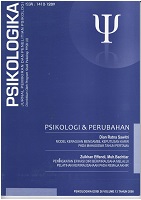Main Article Content
Abstract
The purpose of this research was to test the fairness evaluation Judgement models by Tyler (1994) in house reconstructions to the earthquake victims. There are six possibilities of model tested. The research hypothesis was: "The fairness evaluation judgement models by Tyler (1994) matched with the collected data ",The research sampled 181 earthquake victims on 27 May 2006 that are randomly sampled. Data obtained by using6 scales, namely resource scale, control scale, appraisal of interactional justice scale, appraisal of distributive justice scale, appraisal of procedural justice scale and appraisal of justice impact scale. The data analysis that used was SEM and computed by AMOS ver 6.o. The result of this research showed that the model that matched with the collected data was saturated justice model. This model explained that the resource motives and relational motives had well balanced infiuences to appraisal of distributive and procedural justice.
Article Details
Authors who publish with this journal agree to the following terms:
- Authors retain copyright and grant the journal right of first publication with the work simultaneously licensed under a Creative Commons Attribution-ShareAlike 4.0 International License that allows others to share the work with an acknowledgment of the work's authorship and initial publication in this journal.
- Authors are able to enter into separate, additional contractual arrangements for the non-exclusive distribution of the journal's published version of the work (e.g., post it to an institutional repository or publish it in a book), with an acknowledgment of its initial publication in this journal.
- Authors are permitted and encouraged to post their work online (e.g., in institutional repositories or on their website) prior to and during the submission process, as it can lead to productive exchanges, as well as earlier and greater citation of published work (See The Effect of Open Access).
